
Juan Eslava Galán literary route

Juan Eslava Galán, 1987 Planeta Prize winner, is a prolific author of Jaén, who has published hundreds of articles in magazines, various collaborations in collective works and numerous novels and essays.
His link with Jaén is not only due to his birth in Arjona, but also because of a continuous research work in the province that makes him a great ambassador for Arjona and Jaén. This enables him, in his extensive work, to make continuous references to the history, places, buildings, landscapes, myths and legends of much of the province of Jaén.
This is what he does, for example, in his Planeta Prize (1987), In Search of the Unicorn, which is an exciting journey through the well-known geography of the late 15th century. A fun and exciting adventure, written in old Spanish, that begins in Jaén and takes the protagonist to black Africa. In the Templars and the Table of Salomón, he reveals secrets hidden by the Choir of the Cathedral of Jaén or the Magdalena neighborhood.
The same goes for The Templar’s Tombstone, which he signs under the pseudonym Nicholas Wilcox. The novel begins in Espeluy and takes him to Arjona, but before that, the characters travel through a large number of places in different municipalities of Jaen: Martos, Baeza, Jaén, Torredonjimeno, Alcaudete, Alcalá la Real, Chiclana de Segura, Vilches, Baños de La Encina, Bailén, Arjona, Porcuna, Lopera, Higuera de Calatrava, Úbeda and Santiesteban del Puerto.
Numerous enigmas, places and landscapes that you will enjoy in a special way doing this literary route.
Length of the route
2 kilómeters
Estimated duration
5 hours
Type of route
On foot
PLACES THAT MAKE UP THE ROUTE
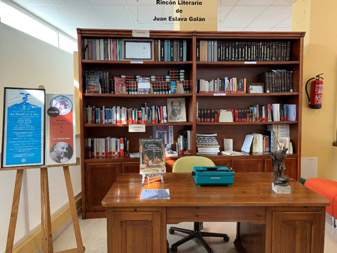
Juan Eslava’s literary corner
A place of special interest and very directly linked to the writer is the “Juan Eslava Literary Corner” in the Municipal Public Library. In it you can find all the works published by the author and ordered by publication date. The works have been donated in their entirety by Eslava Galán and mostly signed. Along with the literary works, the corner has the table in the former office of Juan Eslava Galán, the same one that, together with the typewriter, were used by the aforementioned author for the writing of the Planeta Award “In Search of the Unicorn. The literary…

The Templar Tombstone
The Templar Tombstone, the element that gives the novel its title and that generates its plot, is a marble stone that is located in an unexpected place that the author reveals at the end of the novel. (…) He was on the third rung when he discovered her. There it was, embedded in the wall to the right, under the inclined plane of the second flight of stairs. (…) The Tombstone has the enigma of the Table of Solomon engraved on its external face, by means of a geometric mandala,, which hides the encrypted key to the dominion of the…
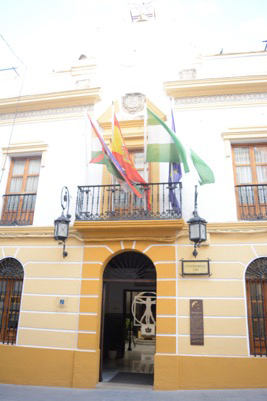
Arjona Town Hall
The building that houses the Arjona Town Hall is a traditional Andalusian-style house from the 19th century that Juan Eslava Galán describes very precisely: (…) The Arjona Town Hall was an Andalusian-style house with a bright, beautiful inner patio with marble flooring and surrounded by columns. Along the walls, a beautiful tile plinth ran halfway up. There were pots of aspidistras in the corners; on the walls, notice boards and large, faded aerial photographs of the town. At the end there was a marble staircase that led to the upper floor. (…) The Arjona Town Hall is one of the…

Crypt of Baron of Velasco
This family funerary crypt, neo-Byzantine style, was built by order of Fernando Ruano Prieto, Baron of Velasco, under the patronal Chapel of his family in the Church of Saint John. The design, by architect Antonio Flórez Urdapilleta, highlights its resplendent golden tesserae, the apse presided over by a Pantocrator, surrounded by four cherubs and three statues sculpted in Carrara marble by the Valencian José Capuz, representing the Theological Virtues (Faith, Hope and Charity). The most unique thing is its ingenious movement mechanism through rails to access the mortuary niches. These were hidden behind the statues and were activated when someone…
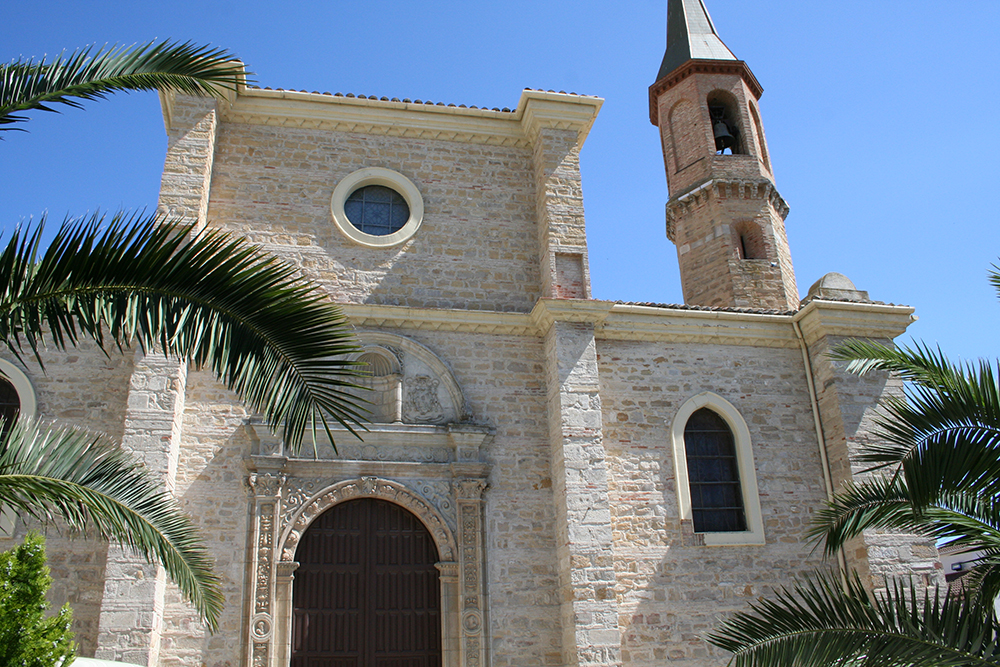
Church of Saint John the Baptist
The Church of Saint John the Baptist is located where most likely a Roman temple dedicated to Bacchus used to be, and later became a Jewish synagogue. In fact, the church is located in the old Jewish quarter of the city. The temple, of late Gothic style, began its construction in the first third of the 16th century. Since then it has undergone several renovations, being practically destroyed in 1936 as a result of the events of the Spanish Civil War. Its typical Plateresque façade stands out, its beautiful and stylized octagonal tower and the rich Sagrario, made by the…
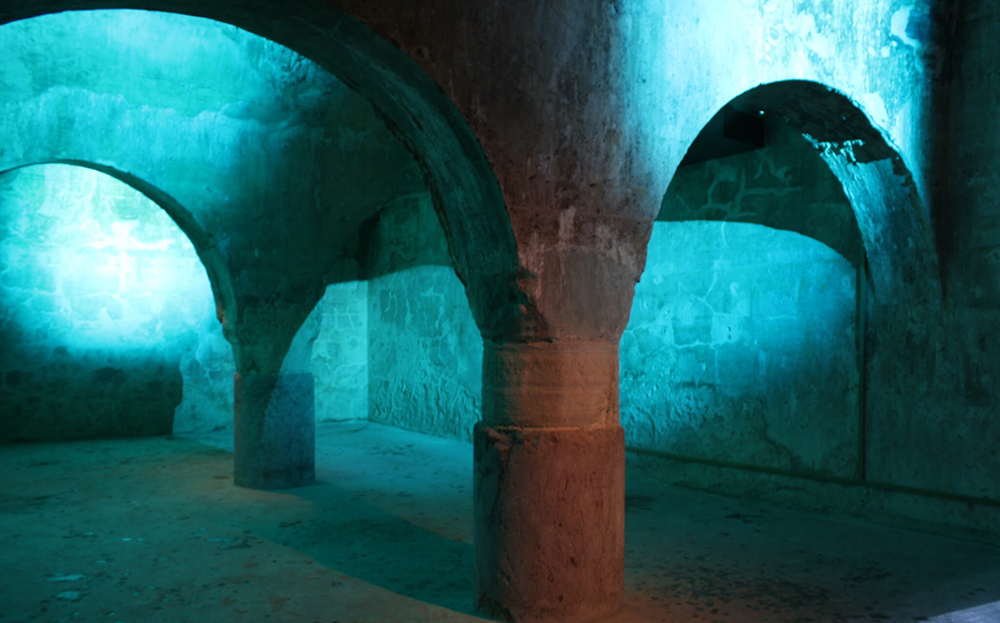
Almohade Water Tank
This water tank, built in the Almohad period, is the oldest building preserved in today’s Arjona and is located under what would have been the Main Mosque of the Alcazaba de Aryuna. Its rectangular-plan structure is supported by three semicircular vaults, raised on Roman alabaster pedestals, reminiscent of the presence of the Roman temple of Urgavo, dedicated to the Emperor Caesar Augustus. The water tank´s function was to contain water to supply the population of Aryuna, which is why the interior is not decorated, its walls being lined with mortar. After a restoration and musealization carried out in 2008, with…
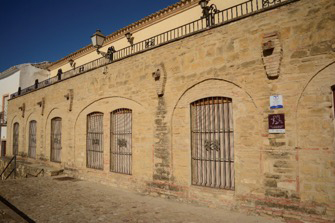
Juan Eslava Galán Museum of Arts and Customs
The Juan Eslava Galán Museum of Arts and Customs is located in the old San Miguel Hospital (also called Casa del Rey as Ibn Alhamar is believed to have been born here) and shares a building with the Arjona Archaeological Museum. This patrimonial landmark is not linked to the work The Templar Tombstone in itself, but to Juan Eslava Galán, who, in addition to giving the Museum its name, donated most of the collection on display. Among the most representative elements on display in the museum, we should highlight the original throne used in the recording of the film Lawrence…
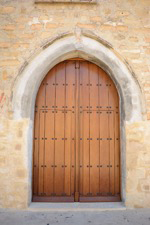
The Templar Bafomet
If we stop to contemplate the austere external ornamentation of the Church of Santa María del Alcázar, we can observe how a face carved in stone appears on one of its side facades as the only and striking decorative motif, the so-called Baphomet of Arjona. Bafomet or Baphomet is a term originally used to describe an idol that the Templar Knights were accused of worshiping and which was later incorporated into different occult and mystical traditions. Its symbolism is usually a head with a split beard and inclined on both sides and / or with two profiles that give rise…

Church of Santa María del Alcázar
The robust Church of Santa María stands majestically in Santa María Square, on the remains of the old Main Mosque of the Alcázar de Aryuna. It was transformed into a Christian temple after the conquest of Arjona by the Christian troops led by King Fernando III in 1244. In The Templar Tombstone this temple is of great importance because on one of its facades there is one of the famous Templars Baphomet, a very significant element in the plot. The Church of Santa María is a completely austere Renaissance building with external ornamentation, with stylistic approaches to Elizabethan Gothic art.…
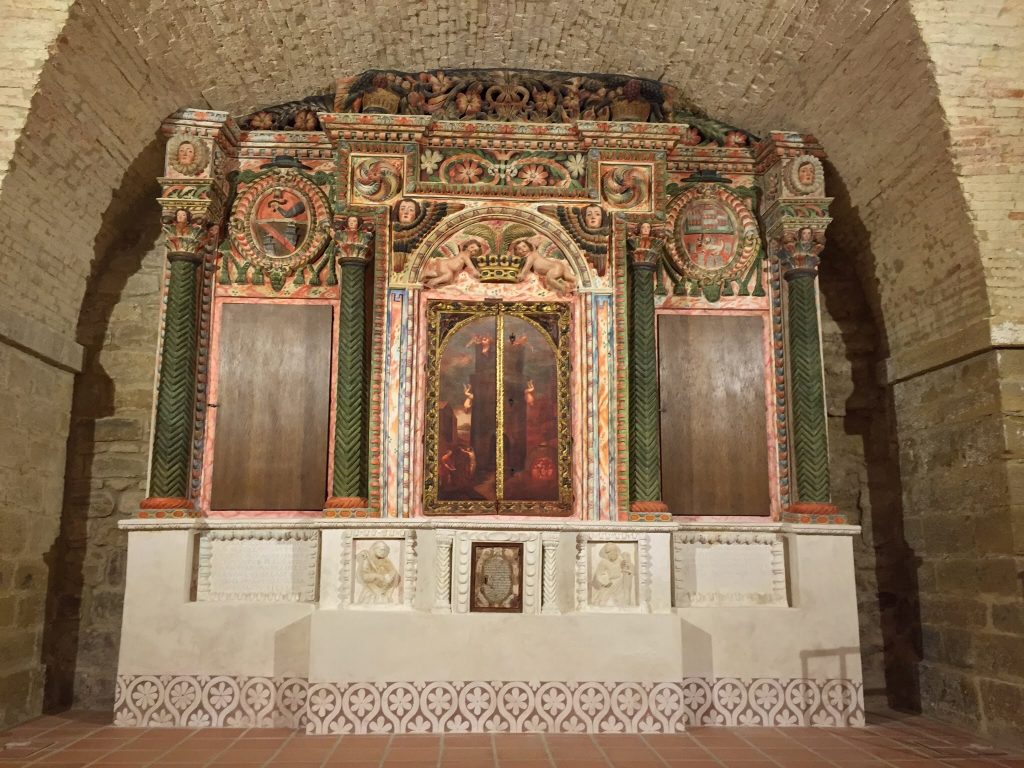
Sanctuary of the Sacred Relics
The Sanctuary of the Sacred Relics (The Saints´Sanctuary or Sanctuary of Alcázar in The Templar’s Tombstone), is a classicist temple dating from the 17th century, the work of the architect Juan de Aranda Salazar. The building rises on the ashlars of the Mocha tower (one of the towers of the old Alcázar) and resolves the unevenness of the land it is built on, structuring on two floors with differentiated accesses through an imposing exterior staircase. On the lower floor, like a crypt, there is a Spanish-American colonial baroque altarpiece sometimes used as an auditorium for many different events. Eslava Galán…

Santa María square
The Plaza de Santa María corresponds to part of the space occupied by the old Alcázar de Aryuna, of which barely the antemural remains, an imposing canvas of a sloping wall based on large masonry of pre-Roman origin, heir to a vast defensive system that would have its maximum splendor in Islamic times (S. IX). The square acts as an excellent viewpoint of the fertile and extensive countryside of Jaén and its spaciousness makes it an ideal space to start the literary route. A square, which the author himself describes in this way in The Templars and the Table of…
Length of the route
18,5 kilómeters
Estimated duration
8 hours
Type of route
On foot and by car
PLACES THAT MAKE UP THE ROUTE

Plaza de Santa María (Cathedral of Jaén)
La Catedral es el gran monumento de la ciudad de Jaén. Este imponente edificio religioso y su belleza y monumentalidad no escapa al interés de Juan Eslava Galán, que la describe de forma sublime en su obra Los Templarios y la Mesa de Salomón. (…) ¡La Catedral de Jaén! Era la primera vez que penetraba en aquel monumento singular. Me cautivó inmediatamente por su contenida belleza. ¡Aquellas altas y silenciosas naves en penumbra, como una armónica caverna tan solo iluminada por la difusa claridad que se filtraba desde las altas vidrieras coloreadas! Los Templarios y la Mesa de Salomón. Capítulo1I.…

Tablas bridge
Puente Tablas is an inhabited settlement belonging to Jaén, is located a few kilometers from the urban center of the capital of Jaen. It is famous for having an Iberian oppidum (fortified city), which has a great patrimonial value and where you can learn how the Iberians of the upper Guadalquivir lived, contemplate one of the largest Iberian fortifications, with more than 300 meters of wall reaching more than 5 meters high, still preserved. Juan Eslava Galán does not miss the opportunity to introduce Iberian culture every time he has the opportunity. For this reason, Juan de Olid, the main…

Bernabé Soriano street
This emblematic street, a reflection of the history of the city of Jaén, is popularly known as “La Carrera”(the Race) because this was where “horse races” were held in the times of Constable Iranzo, as Eslava Galán mentions in his Planeta Award “In search of the unicorn ”. (…) And the Constable raised a handkerchief and signaled and the trumpets sounded and the horsemen let themselves come one against the other, drawing sparks from the stones in a very fierce gallop, their lances drawn, the stronger they were able to bring their horses (…). In search of the unicorn. Chapter…
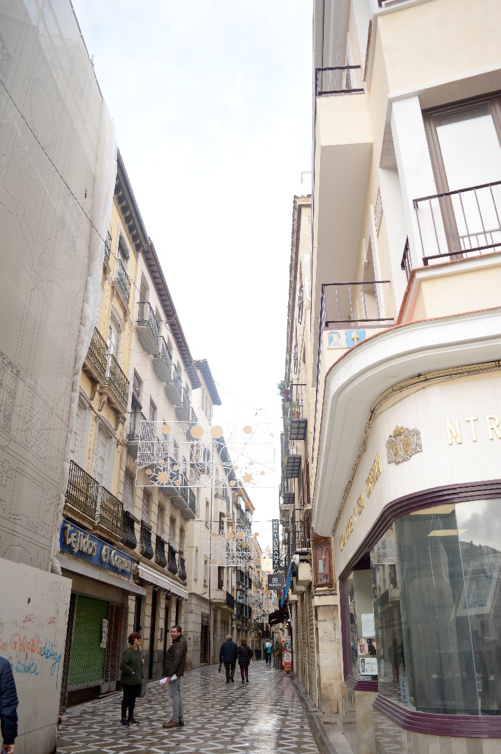
Master Street
Calle Maestra is one of the main arteries of the historic center of Jaén, where numerous shops and the Jaén Tourist Office are located, where you can request more information. The fact of being pedestrian, greatly facilitates traffic and commercial activity in the area. (…) we turned to the right and took the Rúa Maestra and the people had gone to the windows and climbed to the roofs and rooftops and everyone was waving with handkerchiefs and cheering, and it seemed that there was a party and raucous for a great event ( …) In search of the unicorn. Chapter…
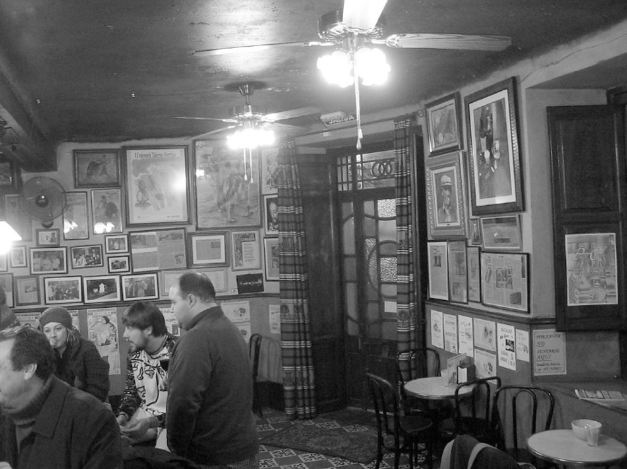
The tavern «El Gorrión»
Juan Eslava Galán makes a nod in his works to one of the oldest taverns in the city of Jaén, was founded in 1888. This tavern also shows a “mummified ham” in the establishment that has a legend about its origin, with two versions. The first and most credible is that José María López Cruz, the first tavern keeper of the dynasty, while hanging several ham pieces in the tavern’s cellar, learned of the end of the First World War and to celebrate it he decided to “forgive” the ham save it from being consumed. The second and more romantic…

San Francisco Square
One of the most emblematic squares of the capital is that of San Francisco, which owes its name to the old monastery built in the middle of the 14th century under the dedication of San Francisco de Asís. The Convent was demolished at the end of the 19th century and on the land it occupied now the Plaza de San Francisco and the Palace of the Provincial Council, project of the architect Jorge Porrúa, stands. A sculpture of the Magdalena fringed with cryptic inscriptions currently presides over the courtyard of the Diputación, in the exact place where the Templar chapel…
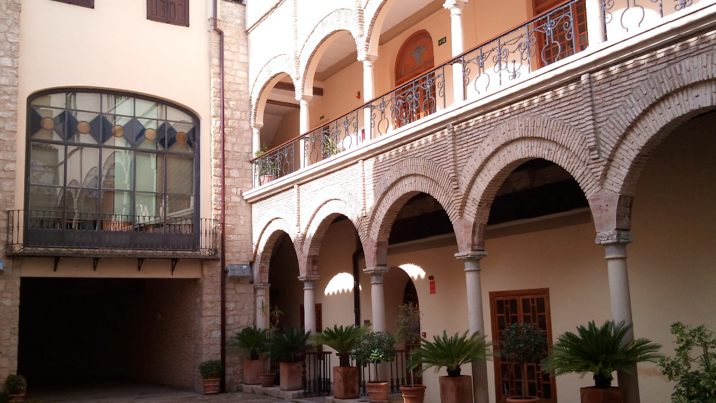
Palace of Condestable Iranzo
Once they arrive in Jaén, the entourage that has to look for and find the unicorn stays at the Palace of the Constable of Castilla, the very illustrious Mr. Miguel Lucas de Iranzo, Mr. Juan de Olid, our peculiar hero. The old Palace, today the seat of the Municipal Board of Culture and Tourism of the city of Jaén, was built in the 15th century, and the Mudejar room is still preserved, the interior of which is covered with a magnificent Mudejar paneling, a unique example of this art throughout city and arcades gallery in the late Gothic courtyard. (…)…
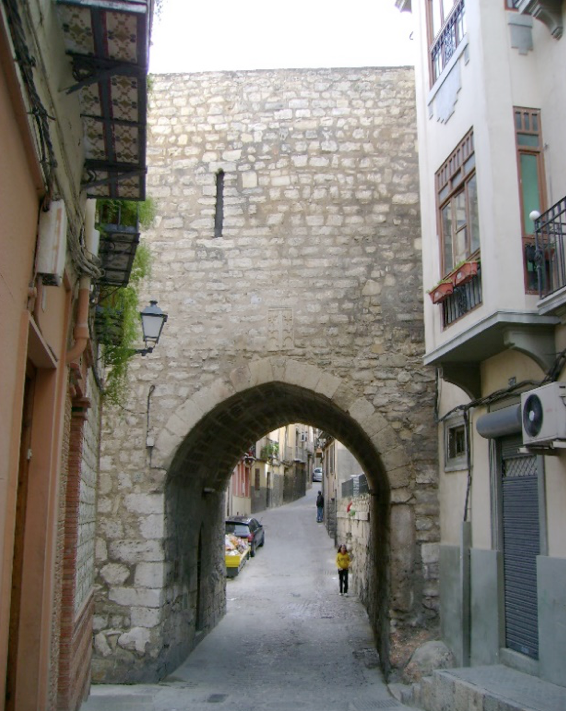
Arch of San Lorenzo
The arch of San Lorenzo is the only remaining vestige of the old church that gives it its name. It dates from the 13th century. Listed as a National Monument since 1877. Located at the confluence of Almendros Aguilar and Madre de Dios streets, A defensive bastion was used for its construction, which was used as a sacristy, whose apse is what remains today as the San Lorenzo arch. The interior is divided into two floors. On the ground floor is the old church chapel, a true treasure of Jaen´s Mudejar art that evokes the Alhambra in Granada. On the…
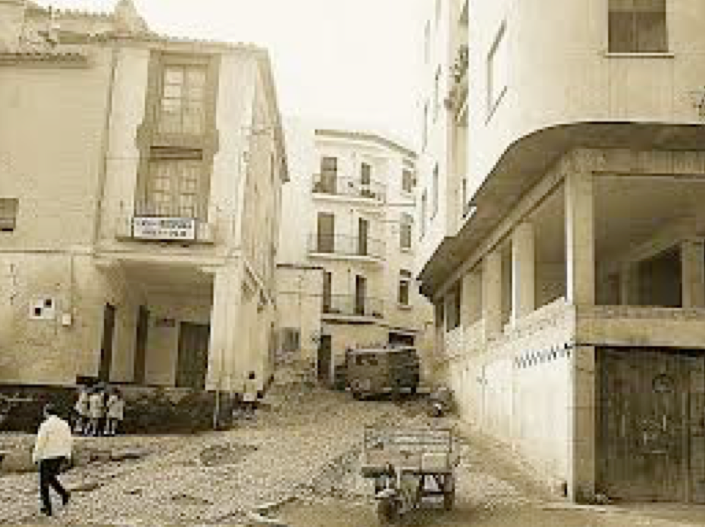
Arrabalejo Tavern
Juan Eslava Galán pays homage in his work to the Arrabalejo tavern, one of the most rooted establishments in the city. The tavern has two floors. On the ground floor there is a restaurant and the upper floor houses an authentic photographic museum of old images. (…) In which two days there was nothing remarkable to say, except that two crossbowmen drunkenly rioted the tavern that they call Arrabalejo, the place where the city’s scoundrel gathers, and one of them received a cut of twelve stitches. (…) In search of the unicorn. Chapter IV.

Arab baths cultural center
The Arab Baths Cultural Center. The Villardompardo Palace is located in the Palace of the First Count of Villardompardo and Viceroy of Peru, Sir Fernando de Torres y Portugal, a Renaissance building from the 16th century. Built in the 11th century, the Arab Baths of Jaén are located in the basements of the Palace and their extension makes them probably the largest visitable baths in Spain. At the end of the 16th century the Count of Villardompardo built his Palace on the Baths, pwhile art of them kept hidden between the foundations and basements, remaining in this way during the…
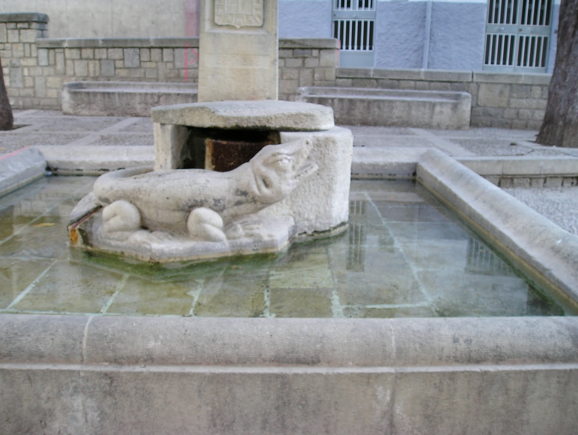
The lizard of La Malena
The Lizard of La Malena (decay for Magdalena, Jaén’s oldest neighborhood and where its mythical lair was located), is the most famous legend of the capital, possibly the most outstanding creation of popular literature. The influence of this legend is such that the lizard has become a symbol of the city, being present in its urban space (statue of the lizard), concerts (Lagarto Rock), on the coat of arms of the Cabildo of the Cathedral, etc. So much so that the legend of the Lagarto de la Malena is one of the ten Treasures of the Intangible Cultural Heritage of…
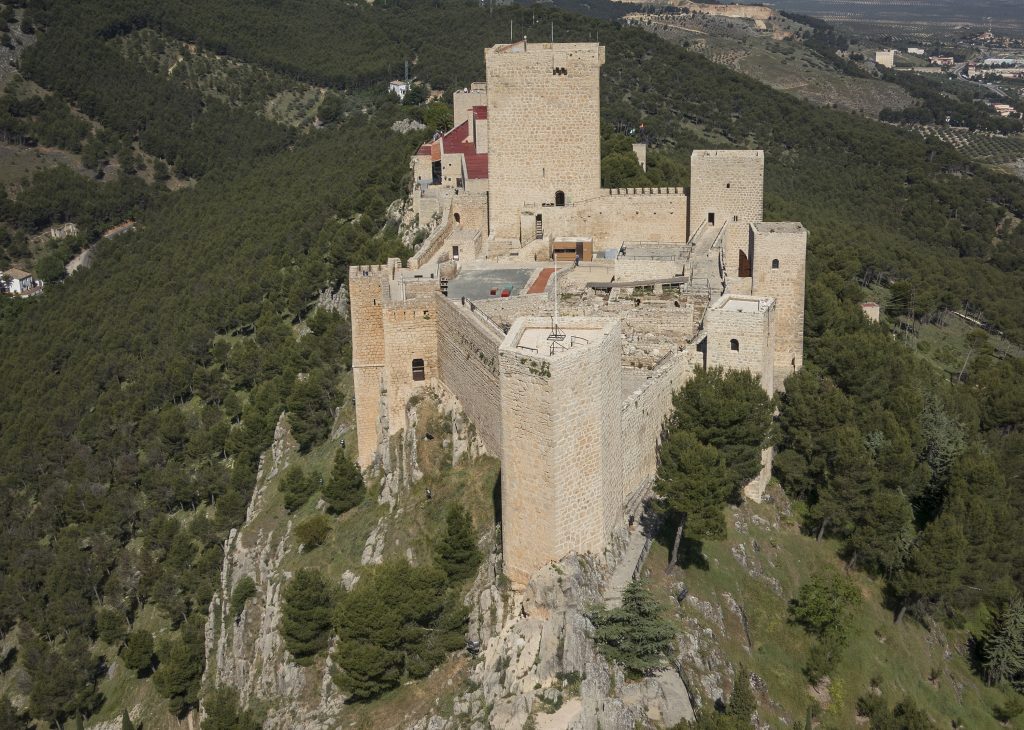
Castle of Santa Catalina
The castle of Santa Catalina, one of the emblems of Jaén, crowns the hill that gives it its name, from where you can see a unique and spectacular landscape of the city and its mountains. It also houses an Interpretation Center which offers a tour of its history. The origin of the fortress is an old caliphate fortress from the 9th century, the Christian castle that has survived to this day was built in the 13th century. After the conquest of the city by Fernando III, its defenses are fortified and turned intoǨ-ñ. an important bulwark against the Nasrid Kingdom…
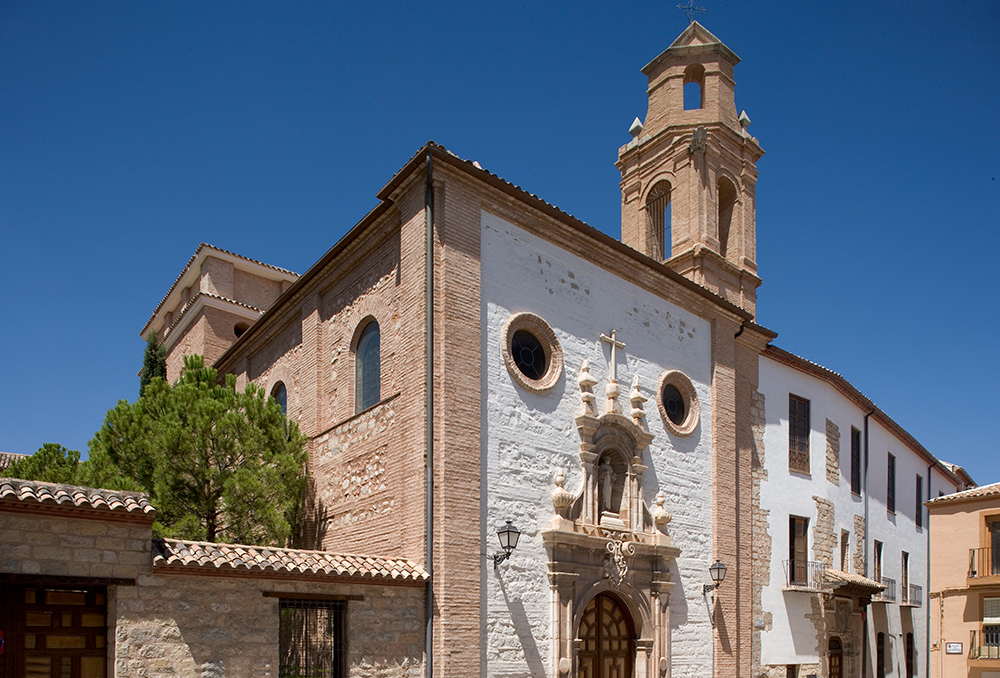
The Institute of Jaen Studies
The Institute of Jaen Studies (IEG), is an Autonomous Body of the Diputación de Jaén that has its headquarters in the Old Hospital of San Juan de Dios de Jaén, a 15th century building, and whose main function is the promotion and study of culture, science and provincial art. Juan Eslava Galán has given his legacy to this institute. More than 8,000 documents from his personal archive (books, press clippings, videos, sound files and other varied objects) to serve as a reference for people interested in Jaén and in this specific author. It is worth introducing the IEG in this…
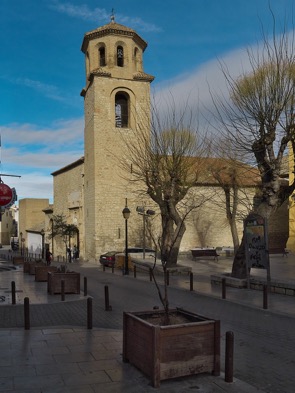
Magdalena Church
The Magdalena Church (originally the mosque of the city, converted into a church after the Christian conquest), is located in the neighborhood of the same name. The church, whose main façade and interior is in the Gothic style, was erected in the 16th century, being one of the oldest churches in the capital of Jaén. In one of the church towers you can still make out the old Arab minaret of the mosque. The neighborhood, the fountain, the lizard and, of course, the Magdalena Church are constant literary resources in the work of Juan Eslava Galán. (…) and thus they…
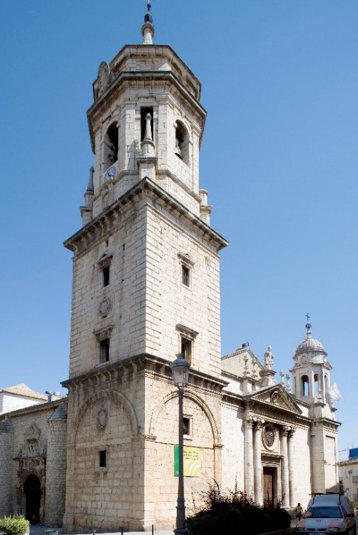
Basílica of San Ildefonso
As stated in the Act of the Virgin´s Descent to Jaén (Archive of the Marian Bibliographic Academy), on June 10, 1430, shortly before midnight, the Virgin descended to the city of Jaén, accompanied by a ghostly procession dressed in white. After a tour of the dark medieval streets, she stopped at the humble parish of San Ildefonso and the miraculous vision vanished. The church became the sanctuary of the Holy Virgin of the Chapel, Patroness of Jaén. That is, the place is chosen by the Virgin herself, which attracts many devotions. The church, declared a Minor Basilica in 2010 by…